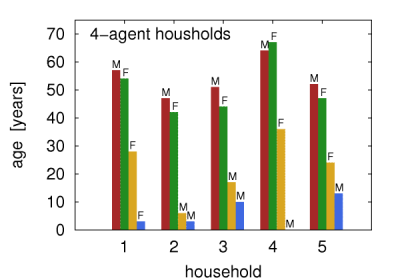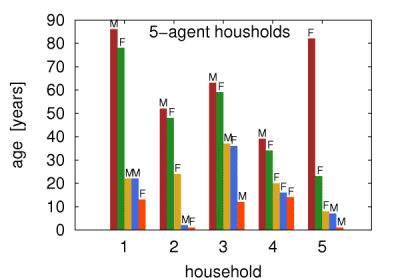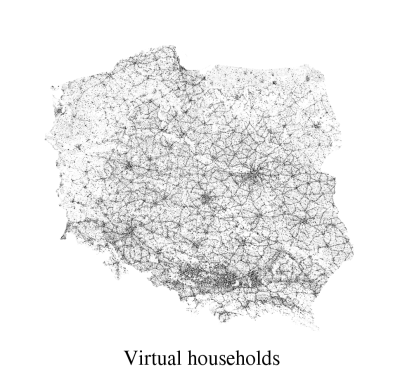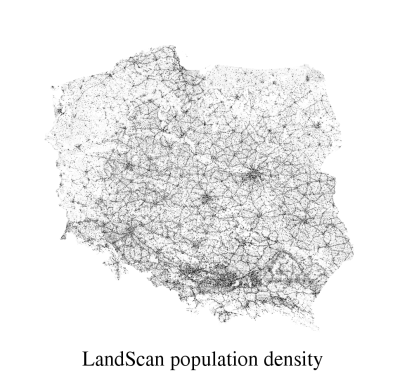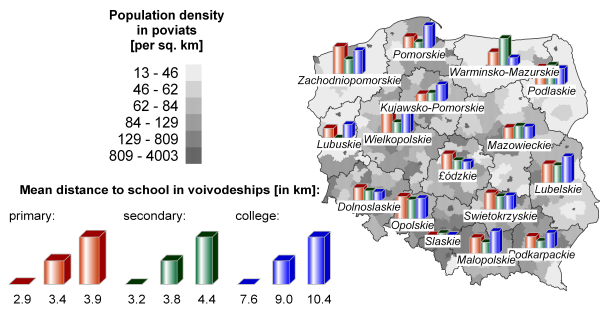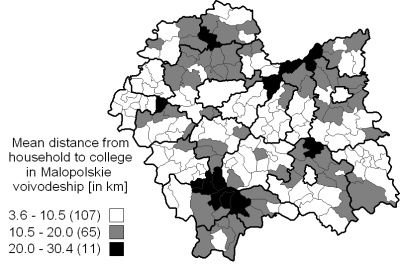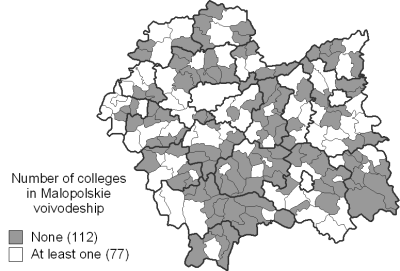Virtual society:results
| Virtual society | Virus spread | Literature | Version | |
|---|---|
| Data | Model | Results |
We are reporting here some selected results describing properties of our Basic Virtual Society model. In such a system various ranges of quantitative analysis can be considered. However, we focus here on the features essential for ongoing epidemiological and transportation studies, as well as on the planned future investigations. Since the methods used for recreation of a given social nodes, e.g. schools and workplaces are in principle similar, we limit the description here only to one selected type of network structure.
Contents
Basic Virtual Society - population and location of households
The obtained population of households reproduced the actual statistics obtained from the NCB. In particular, the number of inhabitants per km2 differs by less than 20 individuals from the values obtained from LandScan, and the size distribution of the households, the distribution of the age difference in couples/parents, the distribution of children number in households, and the distribution of the parents' age are all also well reproduced. Example 2,3,4, and 5-agent households are presented in Figures 1a-d.
Comparison of real and virtual population densities is presented in Figures 2a,b.
Both figures show smaller population density in the NW and NE parts of the country, very high population density in the central-southern region of the country, and in some small concentrated areas corresponding to bigger agglomerations. The biggest conurbation areas are that of the capital city in the central-eastern part of the country, and a highly populated, and industrialized areas in the South. These are the most characteristic features of population density in Poland, and they are accurately well reproduced by our virtual society modeling simulations.
Distance to institution statistics
Once the BVS is created and some basic infrastructure networks such as schools or workplaces are added, it is possible to extract the required population statistics. This would serve as a verification and validation of the model, provided that the corresponding statistical data are available.
Within the virtual society created so far, the mean distances for pupils and students to travel to their respective schools, colleges, as well as for workforce to travel to their workplaces were calculated. In each case the distance was calculated just as a Cartesian distance between two points. The appropriate mean distance statistics were calculated at a commune, poviat, or voivodeship resolutions.
Mean distances from households to schools
The results obtained for the three educational levels (primary and secondary schools, colleges) are presented in Figure 3 at a voivodeship resolution, within the context of population density in poviats.
Typically, the more densely populated a given voivodeship is, the more schools are available and hence, the shorter is the mean household-school distance. Thus, the shortest distances to travel have pupils in Slaskie voivodeship in the South of Poland. This voivodeship is characterized by a rather uniform, high population density. The medium mean distances in Mazowieckie voivodeship (the one that includes the capital city of Warsaw) is the result of relatively short distances in highly populated, and abundant in schools, capital city, and relatively low density population and poor school availability in the surrounding communes.
As a more detailed test case we chose Malopolskie voivodeship located in the southern Poland, mostly because of the surveillance statistics availability for this region[1][2]. Figures 4a-c show colleges availability in communes of Malopolskie voivodeship.
References
- ↑ 1.0 1.1 GUZIK R, Wybrane problemy badawcze geografii spolecznej w Polsce, Kat. Geogr. Ekonom. Uniw. Gdanskiego, Gdynia, 2001, chapt. Dostepnosc szkolnictwa sredniego a szanse zyciowe w obszarach wiejskich, pp. 215-224.
- ↑ GUZIK R, Access to education and the knowledge-based economy in Poland: The regional perspective, in The Annual Anglo-Polish Colloquium "The Knowledge-Based Economy in Central and East European Countries: Exploring the New Policy and Research Agenda", SSEES-UCL, London., 2003


